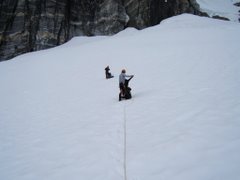
EOS (a weekly science periodical produced for and by scientists) published an article with growing evidences that global warming has likely been underestimated.
The eight reasons-
1) There are two types of aerosols (molecules that reside in our atmosphere)
-those that cool the atmosphere
-those that warm the atmosphere
(whether an aerosol cools or warms largely depends on how much the aerosol absorbs or reflects solar radiation)
The article suggest that future global warming models underestimate warming because the aerosols that warm stay in the atmosphere longer than those that cool.
2)Permafrost is melting fast and furiously. When permafrost (frozen ground) melts the land surface becomes less reflective and more solar radiation is absorbed--- making more permafrost melt.
3)Plants are not breathing/removing as much carbon dioxide as we thought. Plants of many types and at many latitudes have now been monitored--- also our land use practices are favoring draining swamps and burning lands resulting in increased atmospheric carbon dioxide.
4)Arctic sea ice is melting and retreating rapidly--- less ice means less sun is reflected and more heat absorbed by the dark ocean surface... causing more melting (a good analogy is to compare standing on dark asphalt to standing on a light-colored concrete on a sunny day)
5)Atmospheric circulation is intensifying. This is thought to more effectively spread the heat...and create more dramatic weather changes around the world (from droughts to floods)
6)Rapid ice shelf break-up in the Antarctic Penninsula and the increased melt of the Greenland Ice Sheet and acceleration of its outlet glaciers. The melting now going on in Greenland is huge!!! Weather stations that have existed for decades on the snowy and icy edges of Greenland are now surrounded by huge lakes...or completely submerged once again the dark water is absorbing more heat and causing additional melt...
7) Record hurricanes--- high sea surface temperatures (especially in the shallower regions nearshore) promote more hurricanes--- we had the first recorded South Atlantic Hurricane
8) Ocean circulation is changing fast. The North Atlantic has slowed down much faster than originally predicted- this may be due to precipitation changes,and/or increased ice melt.
These eight evidences are well supported by highly recognized science journals... but not often talked about in the news (excepting maybe hurricanes...) Those of us studying these dramatic changes are talking, but are we talking loud enough and to the right people. What is the best way to do this? I think of this often, and try to keep my lights on a little dimmer and look for ways to conserve energy. There are those that think natural geologic forcings are stronger than anything people will do to alter this planet. Because volcanoes, rock weathering and plants naturally alter the carbon cycle and the amount of carbon dioxide in the atmosphere our little bit of carbon burning won't matter. This is much like saying that because most rain is naturally acidic so we might as well burn more coal because more acidic rain is not a big deal...(tell that to an angler in the NE US where fish kills grew rapidly before the clean air act).
Another thing--- that little bit of carbon dioxide people have added to the atmosphere by burning carbon that was once buried in the earth (fossil fuels) is enough to raise temperatures a few degrees above natural levels...Enough to completely melt Greenland possibly in my lifetime.
(Pictured is the Athabasca Glacier, a glacier I helped Dr. Melinda Brugman put a weather station on in Alberta Canada in 1997--- Trey and I went there for our honeymoon in 2003 and the tourist bus that rode onto the glacier only operated because people shoveled snow and ice into the increasingly larger crevasses that were melting out more aggressively each summer...it is likely the snow coach will have to become more creative as melt continues to accelerate)


